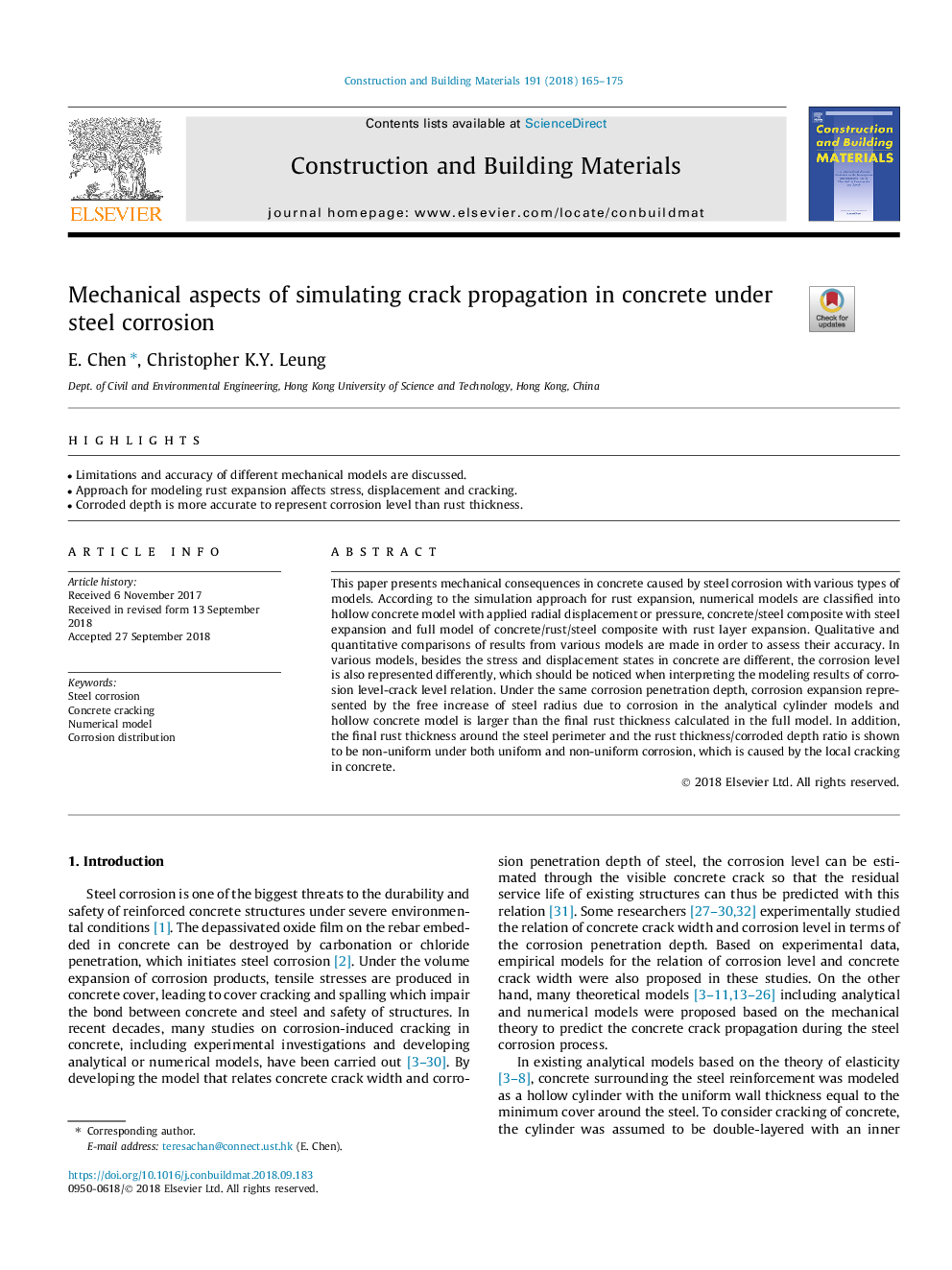| کد مقاله | کد نشریه | سال انتشار | مقاله انگلیسی | نسخه تمام متن |
|---|---|---|---|---|
| 11012618 | 1798144 | 2018 | 11 صفحه PDF | دانلود رایگان |
عنوان انگلیسی مقاله ISI
Mechanical aspects of simulating crack propagation in concrete under steel corrosion
ترجمه فارسی عنوان
جنبه های مکانیکی شبیه سازی انتشار ترک در بتن تحت خوردگی فولاد
دانلود مقاله + سفارش ترجمه
دانلود مقاله ISI انگلیسی
رایگان برای ایرانیان
کلمات کلیدی
خوردگی فولادی، ترک خوردگی بتن، مدل عددی، توزیع خوردگی
ترجمه چکیده
این مقاله اثرات مکانیکی در بتن ناشی از خوردگی فولاد را با انواع مختلف مدل ارائه می دهد. با توجه به رویکرد شبیه سازی برای گسترش زنگ، مدل های عددی به مدل بتونی توخالی با جابجایی یا فشار شعاعی اعمال شده، کامپوزیت بتن / فولاد با گسترش فولاد و مدل کامل کامپوزیت بتن / زنگ زنگ / فولاد با گسترش لایه زنگ طبقه بندی شده اند. مقایسهای کیفی و کمی از نتایج حاصل از مدلهای مختلف به منظور ارزیابی دقت آنها انجام شده است. در مدل های مختلف، علاوه بر وضعیت های استرس و جابه جایی در بتن، متفاوت هستند، سطح خوردگی نیز متفاوت است، که باید در هنگام تفسیر نتایج مدل سازی سطح ارتباط سطح سطح کرنش مشاهده شود. تحت همان عمق نفوذ خوردگی، گسترش خوردگی نشان دهنده افزایش آزاد از شعاع فولاد به علت خوردگی در مدل های سیلندر تحلیلی و مدل بتونه توخالی بزرگتر از ضخامت زنگ نهایی است که در مدل کامل محاسبه شده است. علاوه بر این، ضخامت نهایی زنگ در اطراف محیط فولاد و ضخامت زنگ زدگی / نسبت عمق خوردگی نشان داده شده است که تحت هر دو خوردگی یکنواخت و یکنواخت، که ناشی از ترک خوردگی محلی در بتن است، غیر یکنواخت است.
موضوعات مرتبط
مهندسی و علوم پایه
سایر رشته های مهندسی
مهندسی عمران و سازه
چکیده انگلیسی
This paper presents mechanical consequences in concrete caused by steel corrosion with various types of models. According to the simulation approach for rust expansion, numerical models are classified into hollow concrete model with applied radial displacement or pressure, concrete/steel composite with steel expansion and full model of concrete/rust/steel composite with rust layer expansion. Qualitative and quantitative comparisons of results from various models are made in order to assess their accuracy. In various models, besides the stress and displacement states in concrete are different, the corrosion level is also represented differently, which should be noticed when interpreting the modeling results of corrosion level-crack level relation. Under the same corrosion penetration depth, corrosion expansion represented by the free increase of steel radius due to corrosion in the analytical cylinder models and hollow concrete model is larger than the final rust thickness calculated in the full model. In addition, the final rust thickness around the steel perimeter and the rust thickness/corroded depth ratio is shown to be non-uniform under both uniform and non-uniform corrosion, which is caused by the local cracking in concrete.
ناشر
Database: Elsevier - ScienceDirect (ساینس دایرکت)
Journal: Construction and Building Materials - Volume 191, 10 December 2018, Pages 165-175
Journal: Construction and Building Materials - Volume 191, 10 December 2018, Pages 165-175
نویسندگان
E. Chen, Christopher K.Y. Leung,
